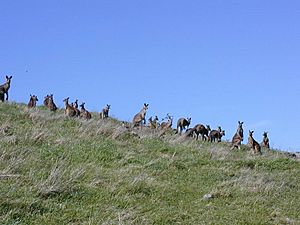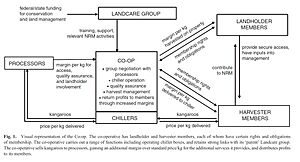Sustainable wildlife enterprise facts for kids
A sustainable wildlife enterprise (SWE) is a smart way of farming. It helps farmers use wildlife like kangaroos in a way that also protects nature. In Australia, farmers work together to use wild animals, often through careful harvesting or by offering ecotourism (nature tours). This helps keep animal populations healthy.
The main idea is to help nature and the environment by using land in new ways. When native animals and plants have a value, it can create new ways for farmers to earn money. This is especially helpful where old farming methods are not as good for the environment or don't make enough profit. The SWE system helps farmers see the value in native animals like kangaroos. It encourages them to look after their land, which helps wildlife and keeps the farm profitable. This idea started in Australia but uses lessons from all over the world.
Contents
Why We Need Sustainable Wildlife Enterprises
For a long time, traditional farming often didn't put a value on natural habitats. This has led to many animal and plant species disappearing. In Australia's dry rangelands, regular farming has sometimes harmed the environment. This is especially true during dry periods, where poor soil and little rain make it hard for nature to grow.
When native wildlife is valued and managed carefully, it helps biodiversity (the variety of life) and animal homes. Sustainable Wildlife Enterprises in Australia learn from places like South Africa and Scotland.
Lessons from Around the World
In South Africa, wildlife is very valuable to private landowners. This makes the future of wildlife there much safer than in other parts of Africa. You can learn more about this in Wildlife of South Africa.
In Scotland, people hunt deer and red grouse (a type of bird) in a way that keeps their numbers healthy. This is because hunting permits belong to the landowners. This gives landowners a reason to protect the animals and their homes. It helps them keep their income.
Australia's native animals, like kangaroos, are perfect for their unique environment. They can handle extreme weather and live well without harming the land too much. Kangaroos are gentler on the land than animals with hooves. They also produce much less methane gas, which is good for the environment. Australia already has a system for harvesting kangaroos in a sustainable way. See the Kangaroo industry for more details. However, in that system, landowners don't usually get money directly from the kangaroos on their land. They only benefit from fewer kangaroos eating their grass.
A Pilot Project in Queensland, Australia
A special pilot project is happening right now in central-south Queensland, in an area called Maranoa.
How the Cooperative Works
In this project, farmers work together in a group called a cooperative. This cooperative owns and runs special cooling boxes. They collect kangaroos from the farms of their members. They use better information and training to make sure kangaroo products are high quality. They can track where the kangaroos came from and how cold they were kept. The trained people in the cooperative also make sure the animals are treated kindly.
The cooperative checks kangaroo populations to make sure they are healthy. They also create and follow strict rules for quality. These rules cover how animals are chosen, harvested, prepared in the field, transported, cooled, and tracked. Farmers benefit from the number of kangaroos harvested on their land. They also get a share of the profits based on their investment and involvement.
Benefits for Everyone
There are different ways these cooperatives can be set up and how profits are shared. Products from SWEs often need to be special to sell well. This helps both farmers and those who harvest the kangaroos. The cooperatives need to show that they help nature, reduce carbon pollution, treat animals humanely, and are open about their work. They also need to show they have the highest quality products.
- Landowners benefit from better management of how many animals are grazing on their land. They also get profits from selling kangaroo products.
- Harvesters can get special rights to work on certain farms and earn a regular income. They are rewarded for using high professional standards. They also get training, resources, and a share in the profits.
- Meat processors get high-quality products that are well-described.
- Environmental groups like Landcare Australia and local natural resource groups find this model helpful. It helps them manage grazing, control wild animals and weeds, and create new income for communities.
Helping the Environment with Carbon Benefits
The growing market for carbon credits in Australia makes using wildlife in farming even more profitable. Cows and sheep produce a lot of methane gas from their stomachs. This methane makes up 11% of Australia's total greenhouse gas emissions. Kangaroos, however, have a different type of stomach. They produce very little methane, which is much better for the environment.
Many people are asking for less red meat from cows and sheep to help reduce carbon pollution. Kangaroo meat is a healthy and environmentally friendly choice. Offering consumers a red meat option that causes much less methane pollution and hardly damages the soil is a big win for the environment.
When kangaroo production takes the place of some sheep or cattle meat production, farmers can earn carbon credits. This means they get credit for reducing greenhouse gases. There are also big chances to earn carbon credits from the soil and plants. This happens when land is managed to help native wildlife, for example, by growing native grasses.



